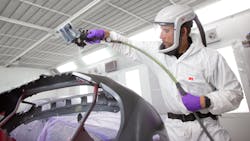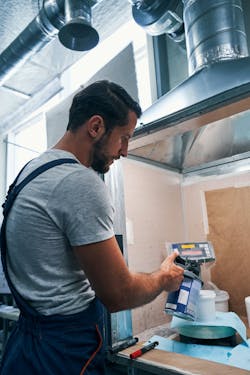It isn’t breaking news to anyone in the FenderBender audience, but getting fairly compensated for paint and materials remains a challenge in modern collision repair. Just like seemingly everything else in the industry, rapid changes have come to the way business is done. What often lags behind in that rip current of change is how shops are getting paid for their work.
There are signs shops are taking notice, however. As of the most recent “Who Pays for What” survey conducted by CRASH Network at the time of this writing, 32% more shops had begun invoicing for paints and materials than were doing so as of the 2021 survey. That showed that the increasingly antiquated multiplier method was on its way out.
So how do shops move into the 21st century when it comes to getting paid for paint and materials? FenderBender spoke with Tony Adams, a business services consultant for AkzoNobel and former shop owner, for some examples from the field of what that modernization process looks like.
The Problem
Adams has been in collision repair for a long time, but he can’t remember an era in which it wasn’t a challenge for shops to get compensated for paint and materials.
“Maybe it worked back in the old lacquer days; maybe it didn’t. I don’t really know,” says Adams, who owned Weaver’s Auto Center in Shawnee, Kansas, for about 25 years. “But as technology has continued to advance and change, we’ve continued to move to a system that really requires pulling up those individual materials of what we use on every job every single time, especially with the complexity of the materials that we’re using today.”
What used to be a simple process has given way to multi-stage finishes and limited-use toners. The multiplier method, in which an estimated materials rate is multiplied by the hours of the job, largely fails to account for these advancements in complexity. While the more precise invoicing method is on the rise, inaccurate paint and materials estimating is costing shops money every day.
“You’ve got some, at least with our company, you’ve got some materials, that special effect toners might be [hundreds of dollars] a liter,” says Adams of AkzoNobel products. “And just using a simple calculation of total hours by dollars is just nowhere near accurate.”
The Solution
As a longtime shop owner turned industry leader and business coach, Adams has seen many examples of shops that either don’t understand or don’t notice the gulf between what they’re spending and what they’re being compensated for. For Adams, properly invoicing for these operations is no different than ensuring accuracy in any other part of running a business.
“The astute business operators really understand and get into the finite details of what it takes to repair this car that’s in my shop at this time because of this claim,” says Adams. “So what am I going to have to do to calculate that?”
For starters, Adams says, shops should be using calculator tools at the start of a repair to produce a more accurate estimate of paint materials costs. There are numerous third-party solutions out there such as PMCLogic and EagleMMS that calculate accurate formulas for the paint operation in question and integrate with most paint company systems. That calculation then gets documented from the very start of the repair.
Adams says one key mistake he’s seen shops make is looking only at paint material thresholds. Using the example of a product that is hundreds of dollars per liter, even using a few ounces could greatly skew a shop’s estimate for a repair. Having an accurate estimate on the front end will give a better sense of what those costs are.
“By the time the vehicle has been painted, the painter is hopefully mixing everything that he or she does across the scale,” says Adams. “We’re going to generate a liquid invoice for what those costs are, and we’ve got to take a look at that in comparison to what we’re actually collecting on the sale of that. And they have to do a line item adjustment, because even though we’ve not hit a threshold, we may be way above that.”
Another forgotten aspect in this process is shop supplies such as filler, sandpaper, and welding papers. Shops often assume these supplies are included with paint materials, says Adams, as part of the refinish process. Instead, shops are missing opportunities.
“It’s spelled out in the P-pages what’s included to do the refinish process,” says Adams. “To refinish typically starts around 400 grit sandpaper and above. So all of those items that we’re using, that’s paint materials. ... So a lot of those materials, because maybe a shop is not charging for feather, prime and block in order to get that back to that of a new, undamaged panel, we’re missing an opportunity on paint material capture there, and then everything that we do from a body shop supply perspective.”
The Aftermath
Adams has seen greater acceptance among shops in the need for paint materials invoicing, particularly with calculations on the front end of the repair. What makes that implementation easier is adding it to a shop’s growing book of standard operating procedures. Doing the same thing every time a car rolls into the shop is the best way to ensure that no cost gets missed.
“We need to have a process,” says Adams, “that says listen, at the time of repair planning, when the vehicles come in, and it’s been 100% meticulously disassembled, and we’ve got the painter to come over and they validated color, and we know whether we’ve got, two-stage, three-stage, quad-stage, whatever the situation may be, we’ve pulled up the formulas, we know how many ounces approximately it’s going to take to do this. And we can get all of those things into consideration.”
The Takeaway
In any business, defaulting to the way operations were done in the past can be a killer of forward momentum. In the collision repair business, it can be especially deadly as shops are battling new technology and new standards on a daily basis. Just as the way cars get painted has changed, so, too, has the way shops need to account for that process.
“It’s important to understand what it takes to run your business,” says Adams, “what it costs to actually repair the vehicle back to the specifications as outlined by the OEM, and/or what it takes to be able to offer your customer a warrantable repair from your refinish company.”
About the Author
Todd Kortemeier
Todd Kortemeier is former editor of FenderBender magazine and started writing as a contributor in 2024.


